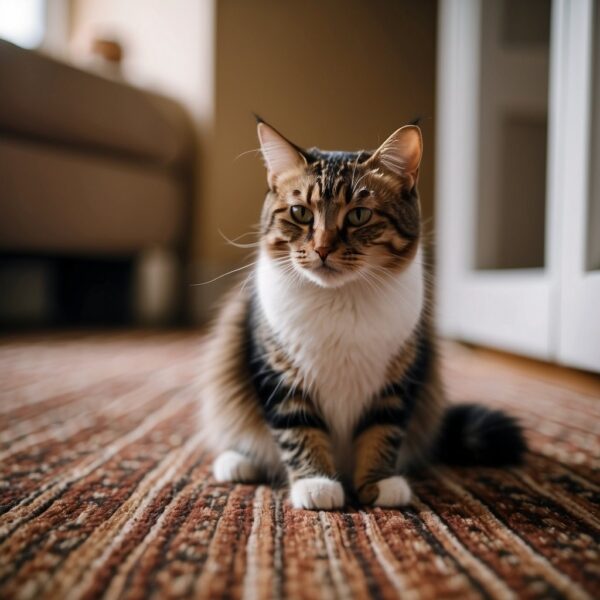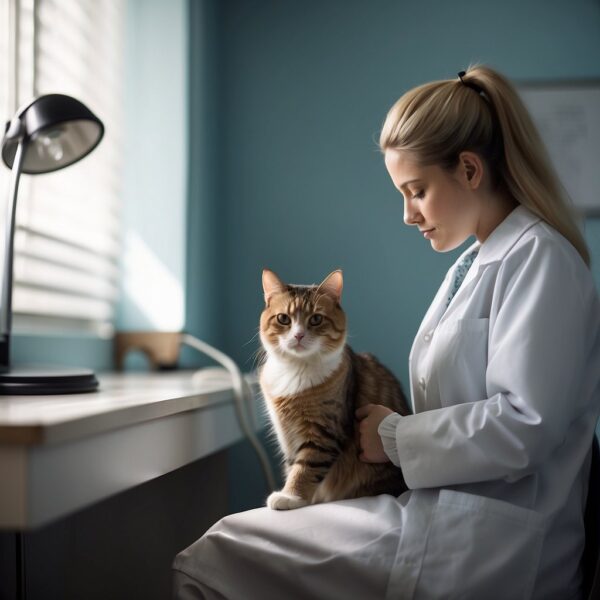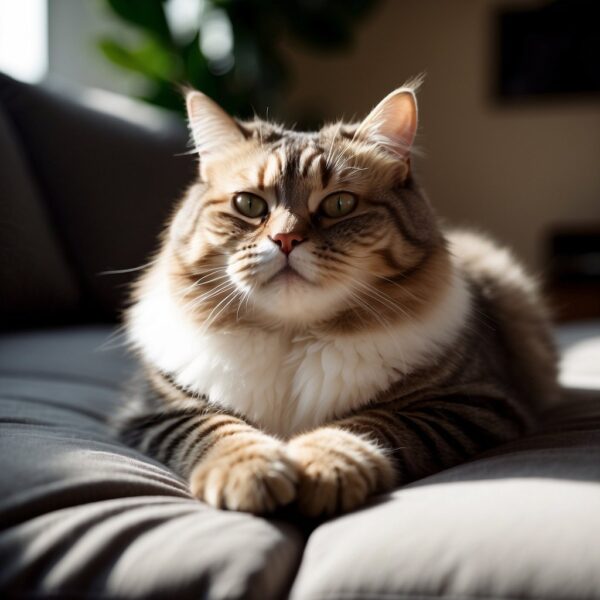
Cat Scooting: Understanding Cat Butt Dragging
Cat scooting is an observable behavior where a cat drags its rear end along the ground, often interpreted by many cat parents as a peculiar or even amusing action. However, this behavior can indicate an underlying health issue that requires attention. While occasional scooting can be normal, particularly as a self-cleaning behavior, frequent or persistent scooting merits closer examination. The primary incitement for a cat to scoot is usually some form of irritation around the anal area.
In many cases, the irritation causing a cat to scoot may involve the anal glands, which can become impacted or infected. Scooting can also be a cat’s attempt to relieve discomfort from parasites, allergies, or fecal matter that has become matted in the fur. Understanding these signs is essential for cat parents to ensure timely and effective care for their cat’s well-being. Thoroughly examining the causes and seeking professional veterinary evaluation are the best courses of action when a cat exhibits scooting behavior. Various treatments are available depending on the underlying issue, ranging from simple cleaning to more intricate medical interventions.
Key Takeaways
- Scooting can be a sign of underlying health issues in cats.
- Key reasons for scooting include anal gland issues, parasites, and allergies.
- Veterinary attention is crucial for proper diagnosis and treatment.
Understanding Cat Scooting
Cat scooting may seem like an odd behavior to many guardians, but understanding the underlying reasons is crucial for the health and well-being of their feline friends.
Definition and Overview
Cat scooting refers to the behavior when a cat drags its rear end along the ground, typically due to discomfort or irritation in the anal region. Though occasionally seen in healthy cats as a cleaning mechanism, frequent scooting warrants a closer look as it may indicate health issues.
Common Symptoms and Signs
The symptoms accompanying cat scooting can vary, but typically include:
- Frequent scooting: An isolated incident may not be a cause for concern, but regular occurrences suggest a deeper issue.
- Anal area discomfort: Indicators such as redness, swelling, or discharge point to discomfort.
- Excessive licking: Cats may lick their anal region excessively due to irritation or pain.
- Unpleasant odor: A foul smell may arise from infected anal glands.
- Visible residue: Sometimes scooting is a response to fecal matter or foreign objects stuck near the anus.

Potential Causes of Scooting in Cats
Scooting in cats is often a symptom of an underlying issue that can range from minor irritations to more serious infections. Identifying the root cause is essential for effective treatment and relief for the cat.
Anal Gland Issues
Cats have two anal glands that secrete fluid during defecation. Issues arise when these glands become impacted or infected, leading to discomfort. A cat may scoot to relieve the pressure or irritation caused by full or infected anal glands.
Intestinal Parasites and Worms
Parasites, such as tapeworms, or other intestinal worms can trigger scooting. These parasites can lead to itching and discomfort around the anal area, prompting a cat to drag their rear on the ground.
Allergies and Skin Irritation
Environmental allergens or food sensitivities can result in skin irritation or dermatitis. Allergies often cause itching and inflammation, which may lead a cat to scoot in an attempt to alleviate the discomfort.
Infections and Inflammatory Conditions
Infections, either bacterial or fungal, as well as inflammatory conditions like proctitis, can cause swelling and discomfort near the cat’s anus. This can prompt scooting as the cat tries to address the sensation of irritation or pain.

Professional Diagnosis and Examination
When a cat exhibits scooting behavior, it is imperative to pursue professional veterinary care for an accurate diagnosis and treatment plan.
Veterinarian’s Role
The veterinarian is central in determining the cause of a cat’s scooting. They bring expertise in diagnosing the issue, whether it is related to anal gland problems, parasites, or allergies. After a thorough discussion about the cat’s medical history and observed symptoms, the vet will suggest an appropriate course of treatment. This may involve tests to rule out potential causes and meticulous analysis to establish a precise diagnosis.
Physical Examination Process
During the physical exam, the vet will conduct a systematic inspection of the cat’s anal region and potentially other areas if symptoms suggest a broader condition. This process includes:
- Visual Inspection: Checking for signs of redness, swelling, or other irregularities.
- Palpation: Gently feeling the anal glands and surrounding areas to assess for impaction or discomfort.
- Additional Assessments: As needed, further diagnostic tests such as fecal exams or blood work to uncover underlying issues like parasites.
With these steps, a veterinarian can accurately diagnose the cause of scooting and administer the appropriate treatment to alleviate the cat’s discomfort.

Treatments for Cat Scooting
Effective treatment for cat scooting involves first identifying the underlying cause. Once determined, various medical interventions can target the issue, whether it be anal gland complications, parasitic infections, allergies, or other health concerns.
Addressing Anal Gland Complications
Anal glands may become impacted or infected, causing discomfort and prompting cats to scoot. Treatment typically involves manually expressing or emptying these glands. In severe cases, antibiotics or surgery may be necessary.
Managing Parasitic Infections
Parasites such as worms can cause irritation leading to scooting. Administering a broad-spectrum dewormer is a common treatment. Maintaining regular flea control is also crucial to prevent related parasitic issues.
Treating Allergies and Skin Issues
Cats with allergies or dermatological conditions may scoot due to itchy skin around their rear. Steroids or other medication prescribed by a veterinarian can alleviate these symptoms. Additionally, hypoallergenic diets can help manage food allergies.
Other Medical Interventions
For various other medical conditions, treatments may include a change in diet, increasing fiber intake, or the use of specific medications to treat underlying issues that may be causing the scooting behavior. A veterinarian should be consulted for proper diagnosis and treatment.
Home Care and Prevention
When it comes to preventing and managing cat scooting, focusing on diet and nutrition, hygiene practices, and regular veterinary care can make a significant difference in a cat’s health and well-being.
Diet and Nutrition Adjustments
A cat’s diet plays a crucial role in digestive health. High-fiber cat foods can assist in creating well-formed stools and prevent constipation, which in turn can reduce instances of scooting. Guardians should ensure their cat’s food includes sufficient fiber to support regular bowel movements. They may also consider a limited ingredient diet or hypoallergenic food if allergies are suspected to be the cause of scooting.
Improving Hygiene
Maintaining a cat’s cleanliness can prevent scooting and address the underlying issues that may cause it. Grooming a cat regularly, especially those with long hair, can prevent fecal matter from becoming trapped near the anus. It’s also important to keep the litter box clean to discourage infections. For cats prone to anal gland issues, occasional gentle cleaning around their rear end can help.
Regular Veterinary Check-ups
Scheduled veterinary visits are essential for overall feline health and particularly for catching and addressing the causes of scooting early. Veterinarians can perform anal gland expressions when necessary and check for common parasites that may cause irritation. They can also advise on flea prevention programs, as parasites contribute to conditions that may lead to scooting behavior.
When to Seek Veterinary Attention
In cases where a cat exhibits unusual or excessive scooting behavior, it is crucial for cat parents to know when veterinary attention is necessary. Recognizing additional symptoms and understanding the implications of recurrent or persistent scooting can help determine the appropriate time to consult a professional.
Observing Additional Symptoms
The presence of additional symptoms in conjunction with scooting indicates the need for veterinary attention. Owners should monitor for signs of:
- Discomfort or pain: Visible signs a cat is in distress.
- Inflamed skin: Redness around the anal area.
- Blood or mucus in stool: Indicates potential infection or parasites.
- Odors or worms: Suggests a possible parasitic infestation.
- Diarrhea: Persistent loose stools can signal health issues.
Any discharge or swelling near the anal sacs warrants an immediate veterinary visit.
Recurrent or Persistent Scooting
Scooting that occurs repeatedly or persists over time should be assessed by a veterinary professional. This behavior can be symptomatic of underlying conditions related to the anal sacs, such as impaction, infection, or abscesses. If a cat’s scooting becomes a regular occurrence, and especially if the scooting is accompanied by any of the above additional symptoms, it is important to seek veterinary evaluation to address potential health issues.

Frequently Asked Questions
This section addresses common inquiries regarding cat scooting, providing specific insights and practical guidance to help cat owners understand and manage this behavior.
What are common causes of cat scooting behavior?
Cat scooting typically occurs when a cat feels irritation around its anal region. Common causes include anal gland issues, parasites, allergies, or fecal matter getting stuck near their rear end.
How does urinary tract infection lead to cats scooting?
Urinary tract infections can cause discomfort and urge to scoot as cats attempt to relieve the irritation. The infection can lead to inflammation of the urinary tract, which causes pain that the cat may try to soothe by dragging its bottom on the ground.
What home remedies can help alleviate scooting in cats?
Adding fiber to a cat’s diet can improve digestion and reduce instances of scooting. Gentle cleaning of the affected area with wipes or warm water can also help, especially after bowel movements.
How can you tell if scooting is due to impacted anal glands in cats?
Signs that a cat’s scooting is due to impacted anal glands include a foul smell, visible scooting, and licking or biting at the area. The glands may also feel swollen when examined.
Why is my cat dragging its bottom on the floor even after defecating?
A cat may drag its bottom on the floor after defecating due to lingering fecal matter or discomfort from diarrhea or constipation. Additionally, poor grooming habits or long hair around the rear can contribute to this behavior.
What steps should you take if your cat is frequently scooting?
If a cat is frequently scooting, consult a veterinarian to identify the underlying cause. A vet can assess for anal gland issues, parasites, or other health concerns and recommend appropriate treatment.